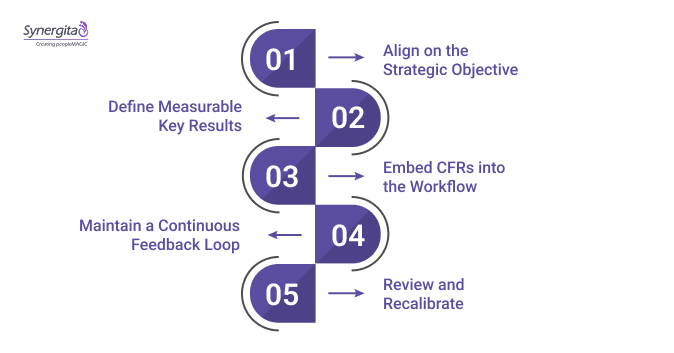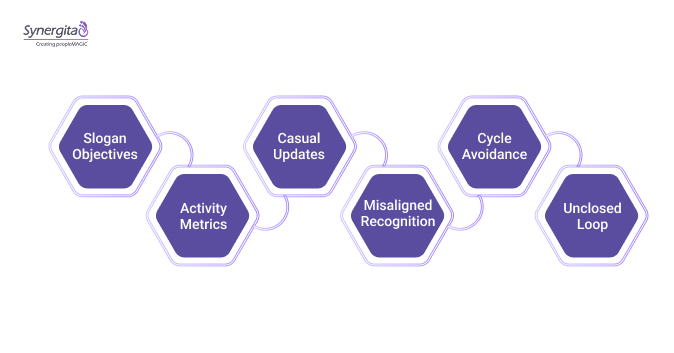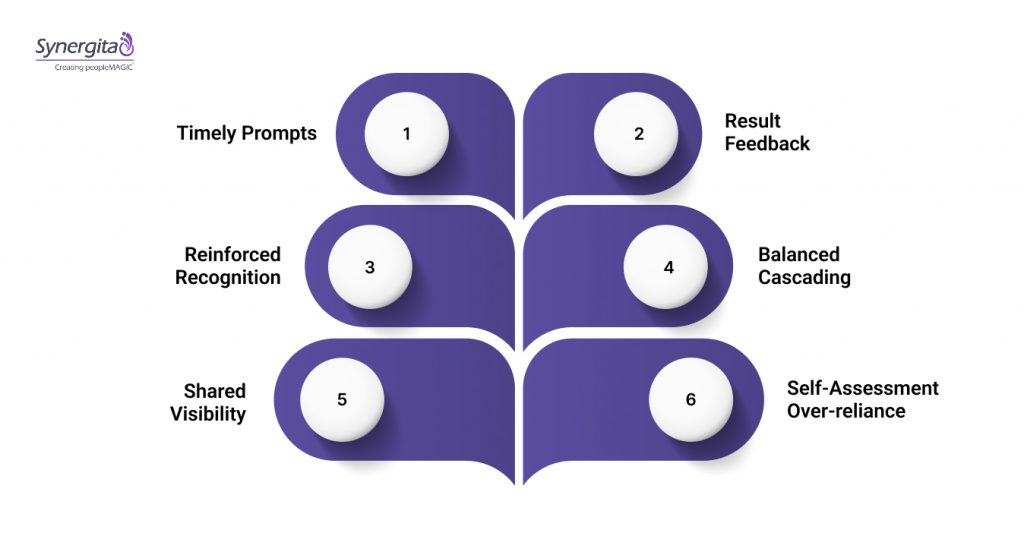Ever noticed how some teams seem unstoppable? They do not just meet goals. They smash them, stay aligned, and keep raising the bar. The difference often comes down to how clearly they connect objectives to daily conversations.
Research shows employees with clarity about their goals are 3.6 times more likely to strongly agree they are motivated to do outstanding work. That is not a small boost in performance. That is the difference between teams that are simply busy and teams that are truly high-performing.
OKRs (Objectives and Key Results) set the direction, but without continuous conversations, feedback, and recognition (CFRs), even the best goals lose momentum. When these two work together, you get a cycle where goals are visible, progress is measured in real time, and achievements are celebrated as they happen.
It is not just about hitting targets. It is about creating a system where everyone knows the “why,” sees the “how,” and feels supported to deliver their best work every single day.
Key Takeaways
- OKRs set a clear destination and define how progress is measured
- CFRs keep those goals active with regular conversations, feedback, and recognition
- Together, they align big-picture strategy with daily work
- Ongoing check-ins allow quick adjustments before targets slip
- Recognition tied to results fuels motivation and keeps wins visible
- Tools like Synergita make the OKR–CFR process effortless and part of everyday workflows
What Are OKRs?
OKRs, short for Objectives and Key Results, are a structured way to connect your team’s daily work with the organisation’s most important priorities. Instead of setting vague targets or chasing too many initiatives at once, OKRs force clarity. They ask two questions:
1. Where do we want to go? (The Objective)
2. How will we know we are getting there? (The Key Results)
The Objective is ambitious but not abstract. It defines the end-state you want to achieve, in plain language that sparks urgency. For example, “Dominate the mid-market SaaS space in APAC” gives a clear direction and target audience, unlike a generic “Increase market share.”
The Key Results transform ambition into evidence. These are measurable milestones that confirm whether the objective is being achieved. In the SaaS example, key results might include “Increase ARR from APAC region by 25%,” “Acquire 150 new mid-market customers,” or “Improve average deal close time to 30 days.”
What separates OKRs from other goal-setting methods is the discipline of focus and measurability. Teams typically set no more than three to five objectives per cycle, ensuring effort is concentrated where it matters most. Each key result is tied to a metric, not an activity, so success can be objectively assessed without subjective interpretation.
In high-performing organisations, OKRs are reviewed and recalibrated frequently, not just filed away in a document. Weekly or monthly check-ins replace end-of-year surprises, allowing leaders to spot misalignment early and course-correct before opportunities are lost. This ongoing visibility turns OKRs into a living management system that drives accountability and adaptability at every level.
What Are CFRs?
CFRs, short for Conversations, Feedback, and Recognition, are the human side of performance management; the ongoing interactions that keep goals alive beyond a planning document. While OKRs define what needs to be achieved and how progress will be measured, CFRs ensure that the path to achieving those goals is supported, guided, and celebrated in real time.
CFRs answer three equally important questions:
- What progress have we made and what stands in our way? (Conversations)
- How can we adjust now to get better outcomes? (Feedback)
- Who has gone above and beyond, and how do we make that visible? (Recognition)
Conversations are scheduled, intentional check-ins between managers and team members that go beyond a status update. They surface progress on OKRs, uncover bottlenecks early, and explore development opportunities. For instance, a weekly one-on-one might reveal that a product launch is delayed not because of poor planning but due to a dependency on another team; something that can be addressed immediately.
Feedback is about course correction in the moment, not a retroactive verdict months later. If a marketing campaign’s early metrics show underperformance, timely feedback can help the team pivot the message or target audience before the quarter’s targets are at risk.
Recognition closes the loop by acknowledging specific contributions that drive results. Instead of generic “good job” praise, recognition within CFRs calls out the behaviour or skill that made the difference; like crediting a developer for optimising backend code that halved page load time, improving user engagement metrics.
What makes CFRs powerful is their ability to transform goal setting from a static exercise into a dynamic system of alignment and motivation. When woven into the daily rhythm of work, CFRs ensure that objectives stay relevant, teams remain engaged, and high performance becomes a consistent habit rather than a one-off achievement.
Here’s an OKR Playbook for Early Startups
The Difference Between OKRs and CFRs
Both OKRs and CFRs shape performance, but they operate in completely different ways. Here’s how they compare in real team scenarios:
| Aspect | OKRs (Objectives and Key Results) | CFRs (Conversations, Feedback, Recognition) |
| Primary Purpose | Define what the organisation wants to achieve and how success will be measured | Keep those goals alive through ongoing dialogue, guidance, and acknowledgment |
| Focus | Ambitious, measurable business outcomes | Continuous performance alignment and motivation |
| Structure | Objective sets the destination, Key Results define measurable milestones | Conversations uncover progress and roadblocks, Feedback drives course correction, Recognition reinforces positive behaviours |
| Measurement | Success tracked via quantifiable results tied to each key result | Impact measured by engagement, adaptability, and sustained high performance |
| Cadence | Typically reviewed quarterly or monthly with regular progress check-ins | Woven into daily or weekly work rhythms for real-time impact |
| Outcome | Clear priorities, alignment, and focus across teams | Stronger collaboration, accountability, and morale that fuels those priorities |
Why You Should Use OKRs and CFRs Together
When OKRs exist without CFRs, they risk becoming a “set it and forget it” exercise. On the other hand, CFRs without OKRs can drift into feel-good conversations with no measurable impact. High-performing teams know that one without the other leaves a gap.
Pairing OKRs with CFRs creates a closed loop:
- Strategic clarity from OKRs ensures every action links back to a bigger organisational priority.
- Real-time engagement from CFRs keeps those priorities front of mind and adaptable to changing conditions.
This combination builds a rhythm where targets aren’t just tracked at the end of the quarter; they’re reinforced, challenged, and refined in the flow of work. Over time, it shapes a culture where people don’t just know the goal, they feel connected to achieving it, and have the timely feedback to adjust before small missteps turn into missed opportunities.
How to Combine OKRs and CFRs

Integrating OKRs and CFRs is not about running two separate systems side by side. It’s about embedding them into a single performance rhythm where strategic goals guide conversations, and conversations drive progress toward those goals.
Stage 1: Align on the Strategic Objective
Before any conversations begin, the leadership team needs to define the big-picture objectives. This means translating the company’s mission and priorities into clear, ambitious statements that can be understood at every level.
Once the objectives are agreed on, they’re cascaded to teams and individuals. This initial alignment ensures every conversation, piece of feedback, and recognition moment is tied to the same organisational priorities.
Stage 2: Define Measurable Key Results
Key Results turn the high-level objectives into tangible evidence of progress. This is where you set the metrics that will serve as conversation anchors throughout the quarter.
Instead of focusing on activities (“launch a new campaign”), Key Results lock onto outcomes (“increase qualified leads by 20%”). These measurable points give CFR discussions a factual baseline to evaluate whether strategies are working.
Stage 3: Embed CFRs into the Workflow
Once OKRs are set, CFRs become the mechanism to keep them alive in daily operations.
- Conversations: Scheduled one-on-ones or team huddles specifically reference OKRs, ensuring discussions go beyond task updates and focus on moving the needle toward Key Results.
- Feedback: Delivered in real time, tied to specific Key Results, helping teams pivot quickly when metrics indicate a need for change.
- Recognition: Celebrating milestones as soon as they’re hit, linking praise directly to the impact on OKRs.
Stage 4: Maintain a Continuous Feedback Loop
OKRs shouldn’t be reviewed only at the end of a quarter. CFRs create an ongoing loop where progress is tracked, roadblocks are addressed early, and small wins are acknowledged to sustain momentum.
This prevents the common problem of “set it and forget it” OKRs and ensures that adjustments happen when they can still make a difference.
Stage 5: Review and Recalibrate
At the end of each cycle, OKRs and the effectiveness of the supporting CFRs are evaluated together.
- Were the objectives met, and if not, why?
- Did conversations and feedback lead to timely course corrections?
- Was recognition specific and impactful enough to reinforce desired behaviours? Insights from this review inform the next cycle, making both the goal-setting and the engagement process sharper over time.
Common Pitfalls When Implementing OKRs and CFRs

Even well-intentioned organisations often stumble when putting OKRs and CFRs into practice. The framework itself is simple, but the execution demands discipline, cultural alignment, and constant fine-tuning. These are the traps that can derail progress.
Setting objectives that read like slogans
An objective that says “Be the market leader” might sound inspiring, but it leaves teams guessing what actions will get them there. Without a specific scope, timeline, or success indicator, teams lose momentum. Objectives must carry enough detail to direct action without micromanaging the process.
Measuring activity instead of outcomes
One of the fastest ways to weaken OKRs is by turning Key Results into a task list. “Hold five customer meetings” measures effort, not impact. In contrast, “Increase net promoter score by 10 points” evaluates whether those meetings created real value. Focusing on outputs over inputs keeps the team honest about what truly moves the needle.
Letting CFRs turn into casual updates
When conversations become generic status reports, they stop influencing outcomes. A meaningful CFR focuses on where the team stands against its Key Results, what is blocking progress, and what course corrections are needed now. The absence of this focus leads to polite but unproductive check-ins.
Recognition that misses the mark
Acknowledging effort is important, but if praise is detached from measurable achievements, it loses its power to reinforce desired behaviours. Celebrating a “great job” means little unless it is linked to a specific Key Result or a critical milestone that directly advances the objective.
Avoiding mid-cycle adjustments
Some teams treat OKRs like quarterly contracts that cannot be touched until review time. In fast-moving markets, this rigidity means goals can become irrelevant long before the cycle ends. High-performing teams revisit OKRs mid-cycle, adjusting Key Results or re-prioritising objectives to stay aligned with real-world changes.
Failing to close the loop
Without end-of-cycle reflection, lessons are lost. Teams may hit targets without understanding why or miss them without identifying the root cause. Reviewing both the outcomes and the quality of CFRs ensures that every cycle improves the next, turning OKR–CFR integration into a compound learning process rather than a reset button.
How Synergita Makes CFRs and OKRs Easier to Sustain

Setting OKRs is only half the challenge. The bigger hurdle is making them an active part of the workweek so that they guide decisions, inspire conversations, and drive measurable results. Many platforms help you record goals. Synergita helps you live them every day.
Synergita works as a performance rhythm platform, embedding OKRs and CFRs into the flow of work rather than treating them as separate management exercises.
Built-in prompts for timely conversations
Managers and employees receive context-aware reminders to have meaningful one-on-one or team discussions. These prompts are linked to current OKR progress, deadlines, and recent feedback so that every conversation is focused on actual performance drivers rather than generic updates.
Feedback directly connected to Key Results
All feedback in Synergita is tied to specific measurable outcomes. This keeps discussions grounded in facts, helps teams identify what is working, and enables quick action when progress stalls.
Recognition that reinforces results
Appreciation flows instantly through the platform whenever milestones are achieved. Whether it is a sales target exceeded or a product improvement delivered, recognition is visible across teams and linked directly to the OKRs impacted.
Cascading OKRs that balance alignment with flexibility
Corporate objectives cascade down through departments and teams while still giving each group room to adapt to their operational context. This prevents the disconnect between leadership strategy and day-to-day execution.
Visual dashboards for shared visibility
Dashboards combine performance data with contextual insights, making it easy for everyone to see not only what has been achieved but also how it was achieved. This transparency strengthens accountability and ownership at every level.
Integration into existing workflows
Synergita fits into your normal schedule without adding administrative overhead. Conversations, feedback, and recognition happen within the rhythm of ongoing work, ensuring that engagement with OKRs and CFRs remains consistent long after implementation.
Start a free trial and experience how Synergita transforms OKRs and CFRs from static plans into a continuous performance culture.
Final Thoughts
High performance doesn’t happen by accident. It’s the product of clear goals, measurable progress, and constant, meaningful engagement. OKRs give your organisation the direction and evidence it needs, while CFRs keep the momentum alive through conversations, feedback, and recognition. But the real impact comes when these two frameworks work in unison, not in isolation.
This is where Synergita stands out. Instead of juggling separate tools or manual processes, you get a single platform that aligns every objective with ongoing performance dialogue. The result is faster course corrections, greater accountability, and a culture where employees feel motivated to deliver outstanding work.
If you want your OKRs to be more than a slide in a quarterly review deck, it’s time to see how Synergita can make them part of your everyday operations.
Book your personalized demo today.
FAQs
Q: What is a CFR OKR?
A: CFR and OKR work together to improve performance. OKRs are about setting and measuring goals, while CFRs focus on the human side through regular conversations, feedback, and recognition. Together, they keep both progress and people on track.
Q: What is CFR in performance management?
A: CFR stands for Conversations, Feedback, and Recognition. It is a continuous performance management approach that supports employees beyond targets, helping them stay aligned, engaged, and motivated throughout the work cycle.
Q: What is better than OKR?
A: It is not about what is better, but what works better together. OKRs are powerful for setting direction. When paired with CFRs, they become more adaptive and people-focused, leading to higher team performance and better outcomes.
Q: What is an example of CFR?
A: A weekly one-on-one where a manager gives feedback, discusses progress blockers, and appreciates a team member’s recent efforts is a strong example of a CFR in action.
Q: How does CFR work?
A: CFRs work by creating regular touchpoints between team members and managers. These can be informal chats, peer feedback moments, or quick shout-outs that help teams stay connected, adjust quickly, and feel valued.
Q: Why use OKR instead of KPI?
A: OKRs focus on ambition and progress, helping teams stretch toward meaningful outcomes. KPIs measure what is already being done. While both have their place, OKRs are better for driving change and alignment in fast-moving teams.


